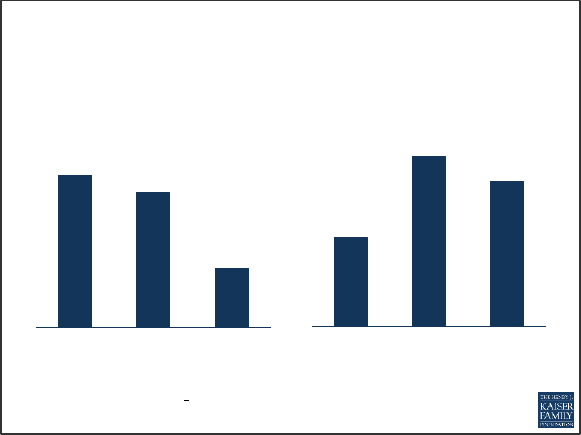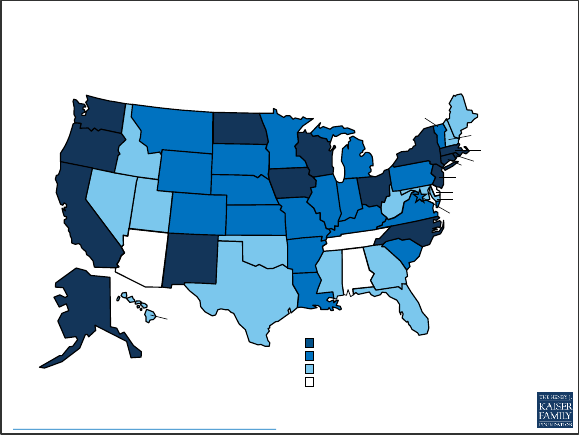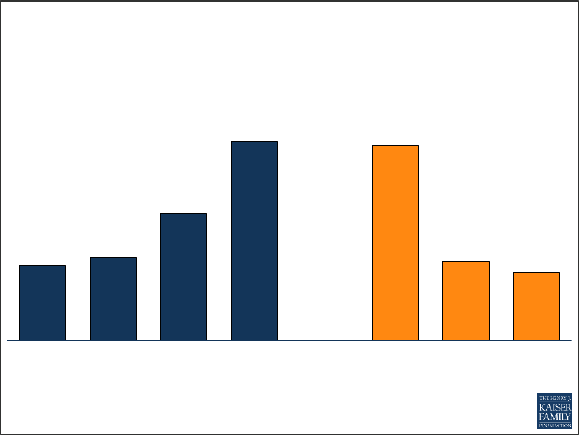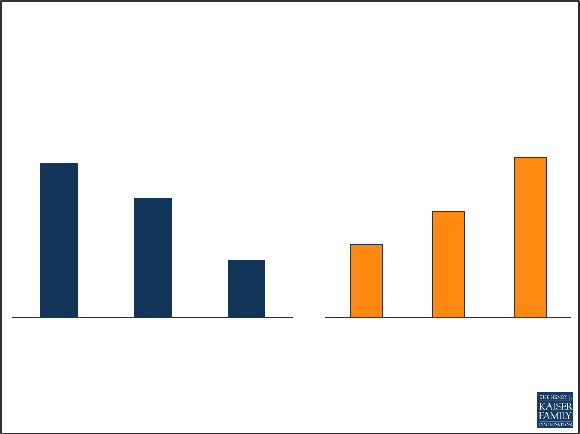
March 2016 | Issue Brief
Access to Dental Care in Medicaid: Spotlight on Nonelderly
Adults
Elizabeth Hinton and Julia Paradise
Introduction
Oral health is a critical but often overlooked component of overall health and well-being.
1
Although good oral
health can be achieved through preventive care, regular self-care, and the early detection, treatment, and
management of problems, many people suffer from poor oral health, which often has additional adverse effects
on their general health and quality of life.
2
The prevalence of dental disease and tooth loss is disproportionately
high among people with low income, reflecting lack of access to dental coverage and care. Racial and ethnic
disparities in these measures are also pronounced.
Medicaid, the major health coverage program for low-income Americans, provides a uniquely comprehensive
mandatory benefit package for children that includes oral health screening, diagnosis, and treatment services.
In the last decade, with federal and state leadership, Medicaid and the Children’s Health Insurance Program
(CHIP) have made important progress in addressing gaps in low-income children’s access to dental care,
boosting children’s use of preventive and primary dental services. However, even with a robust benefit package,
securing access to dental providers and services has remained a key challenge. The situation for low-income
adults in Medicaid is more complex than that for children. Dental benefits for Medicaid adults are not required
by federal law, but are offered at state option, and most states provide only limited coverage – in many cases,
restricted to extractions or emergency services. Further, when states have faced budget pressures, adult dental
services in Medicaid have typically been among their first cutbacks.
3
It is noteworthy, too, that the Medicare
program, which covers elderly adults and nonelderly adults with disabilities, provides no dental benefits.
Comprehensive coverage of dental care for children in Medicaid and CHIP, as well as the designation of
pediatric dental care as one of the ten essential health benefits (EHB) under the Affordable Care Act (ACA),
indicate recognition among policymakers of the importance of oral health. New opportunities now exist to
establish similarly robust oral health benefits for low-income adults. Broad state flexibility to define Medicaid
benefits for adults, the ACA expansion of Medicaid to nonelderly adults up to 138% of the federal poverty level
(FPL), and Medicaid payment and delivery system reform are key policy levers. To help inform federal and
state action concerning adult access to oral health care, this brief examines the oral health status of low-income
adults, the dental benefits covered by state Medicaid programs, and low-income adults’ access to dental care
today.

Access to Dental Care in Medicaid: Spotlight on Nonelderly Adults 2
Why adult oral health is important
Untreated oral disease can have serious adverse impacts. Untreated oral health problems can affect appetite
and the ability to eat, or lead to tooth loss, all of which can lead, in turn, to nutrition problems.
4
Untreated
problems can also cause chronic pain that can affect daily activities such as speech or sleep.
5
Research has also
identified associations between chronic oral infections and diabetes, heart and lung disease, stroke, and poor
birth outcomes.
6
Oral health problems can also interfere with work; employed adults are estimated to lose
more than 164 million hours of work each year due to oral health problems or dental visits.
7
Adults who work in
lower-paying industries, such as customer service, lose two to four times more work hours due to oral health-
related issues than adults who have professional positions.
8
Visibly damaged teeth or tooth loss can also harm
job prospects for adults seeking work.
Dental disease prevalence in nonelderly adults
Nationally, 27% of all adults age 20-64 have
untreated dental caries, but the burden of disease
is not distributed evenly in the population.
9
The
rate of untreated dental caries is highest (44%)
among adults with income below 100% FPL
($11,880 per year for an individual in 2016) –
more than twice the rate (17%) among adults
with income at or above 200% FPL (Figure 1).
Racial and ethnic minorities were also
disproportionately affected by oral health
problems. Both Black and Hispanic adults had
significantly higher rates of untreated caries than
Whites, largely a reflection of their higher rates of
poverty.
Medicaid’s role in covering low-income adults
In 2014, Medicaid covered nearly 28 million low-income nonelderly adults. The program covers 4 in every 10
nonelderly adults under the poverty level.
10
As of February 2016, 31 states and DC had adopted the Affordable
Care Act’s (ACA) Medicaid expansion, which provides Medicaid eligibility to nearly all adults with income at or
below 138% FPL ($16,394 per year for an individual in 2016); 19 states have not adopted the Medicaid
expansion. The uninsured rate among low-income adults remains high, especially in non-expansion states.
11
Across non-expansion states, the median Medicaid income eligibility for parents is 44% FPL, and adults
without dependent children, except pregnant women and people with disabilities, are excluded from Medicaid
no matter how poor they are. An estimated 2.9 million adults with income below 100% FPL fall into the
“coverage gap” across non-expansion states – without access to Medicaid coverage and unable to qualify for
subsidies in the Marketplace.
12
Figure 1
44%
39%
17%
<100% FPL 100-199% FPL ≥200% FPL
*
*
NOTES: Adults age 20-64. *Difference from >200% FPL is statistically significant at p<0.05. ^Difference from White is statistically
significant at p<.05.
SOURCE: KFF analysis of National Health and Nutrition Examination Survey (NHANES), 2011-2012.
Prevalence of Untreated Dental Caries Among Nonelderly
Adults, by Income and Race/Ethnicity, 2011-2012
22%
42%^
36%^
White Black Hispanic

Access to Dental Care in Medicaid: Spotlight on Nonelderly Adults 3
Medicaid dental benefits for adults
States have considerable discretion in defining Medicaid adult dental benefits because these services are
optional, not mandatory, under federal Medicaid law. Adult dental benefits are a state option across the board
– for adults who qualify for Medicaid under pre-ACA law and also for adults newly eligible for Medicaid under
the ACA expansion. States must provide Alternative Benefit Plans (ABPs) for Medicaid expansion adults,
modeled on one of four "benchmark" options specified in the law, including an option for coverage approved by
the HHS Secretary. All ABPs must include the ten essential health benefits (EHBs) established by the ACA.
13
Notably, the EHBs include pediatric dental benefits, but not adult dental benefits.
14
Many states have used the
Secretary-approved coverage option to conform the benefits they provide for expansion adults with their
benefits for adults in traditional Medicaid, modifying them as necessary to comply with the EHB requirements.
Of the 31 states and DC that have adopted the Medicaid expansion, all but two states provide the same dental
benefits for expansion adults that they do for the traditional adult Medicaid population. The two exceptions are
Montana and North Dakota. Montana provides limited dental benefits for its traditional Medicaid adult
population, but none for Medicaid expansion adults; North Dakota provides extensive dental benefits for
traditional Medicaid adults, but none for expansion adults.
Almost all states (46) and DC currently provide some dental benefits for adults in Medicaid (Figure 2 and
Appendix). However, just as commercial dental plans typically do, many state Medicaid programs set a
maximum on their per-person spending for adult dental benefits or impose caps on the number of certain
services they will cover. The scope of Medicaid adult dental benefits varies widely by state. As of February 2016,
15 states provided extensive adult dental benefits, defined as a comprehensive mix of services including more
than 100 diagnostic, preventive, and minor and
major restorative procedures, with a per-person
annual expenditure cap of at least $1,000.
Nineteen states provided limited dental benefits,
defined as fewer than 100 such procedures, with
a per-person annual expenditure cap of $1,000
or less. The remaining 13 states with any adult
dental benefits covered only dental care for pain
relief or emergency care for injuries, trauma, or
extractions. Four states provided no dental
benefits at all.
15
Even in states that provide some
dental benefits, adult Medicaid beneficiaries may
face high out-of-pocket costs for dental care,
making it difficult or impossible to afford.
As optional Medicaid services, adult dental benefits are also subject to being cut. Many states change their
benefits from one year to the next. In particular, when states are under budget pressures, adult dental benefits
in Medicaid have been cut back and, when their economies improve, states often move to restore them. For
example, in 2009, California eliminated coverage of non-emergency dental services for adults. In 2014, the
state restored many of the benefits, including preventive and restorative care, periodontal services, and
dentures. Similarly, Illinois eliminated coverage of non-emergency dental services for adults in 2012, but
Figure 2
SOURCE: Medicaid Adult Dental Benefits: An Overview, Center for Health Care Strategies, Inc., February 2016,
http://www.chcs.org/resource/medicaid-adult-dental-benefits-overview/
Medicaid Coverage of Adult Dental Benefits, February 2016
WY
WI
WV
WA
VA
VT
UT
TX
TN
SD
SC
RI
PA
OR
OK
OH
ND
NC
NY
NM
NJ
NH
NV
NE
MT
MO
MS
MN
MI
MA
MD
ME
LA
KY
KS
IA
IN
IL
ID
HI
GA
FL
DC
DE
CT
CO
CA
AR
AZ
+
AK
AL
Emergency-only benefits (13 states)
Extensive benefits (15 states)
Limited benefits (19 states)
No dental benefits (4 states)

Access to Dental Care in Medicaid: Spotlight on Nonelderly Adults 4
expanded services again in 2014 to include limited fillings, root canals, dentures, and oral surgery services.
16
Research has shown that when states reduce or eliminate adult dental benefits, unmet dental care needs
increase, preventive dental service use decreases, and emergency department use for dental problems
increases.
17
18
19
Adult access to dental care
Access to and use of dental care among low-income adults depends on a number of variables. Medicaid
eligibility for low-income adults, Medicaid coverage of dental benefits, the availability of dental providers, and
beneficiary and provider awareness of the importance of preventive dental care all bear on whether low-income
adults obtain dental services. Particularly in the absence of dental benefits, cost is the main barrier to access to
dental care for low-income adults.
20
Paying for services out-of-pocket is difficult, if not impossible, on their
strained budgets. Over time, persistent lack of access to dental care or connection with dental providers may
result in low expectations for oral health among low-income adults, reinforcing existing disparities. And if
consumers are unaware of the need for regular checkups or cannot afford them, they may wait until they
experience oral pain to seek care.
DENTAL CARE UTILIZATION AND UNMET NEED
Regular dental care is important to maintaining good oral health. Low-income adults are less likely to have
seen a dental provider within the last year than higher-income adults. In 2013, only about 1 in 5 adults with
income below 200% FPL had a dental visit in the past year, compared to 1 in 3 of those with income of 200-
399% FPL, and 1 in 2 adults with income above 400% FPL (Figure 3). Similarly, adults with private dental
coverage were more than twice as likely as adults with Medicaid/CHIP or uninsured adults to have seen a
dental provider within the last year. (Note: “Uninsured” includes adults without private dental benefits or
Medicaid and nonelderly Medicare-only adults
who do not have private supplemental dental
benefits.) In 2013, 49% of adults with private
coverage had a dental visit in the last year,
compared to 20% of adults with Medicaid/CHIP
and 17% of uninsured adults. Children in
Medicaid/CHIP, for whom dental benefits are
mandatory, were much more likely than adults in
Medicaid to have had a dental visit (42%).
21
The
low visit rate for adults with Medicaid/CHIP
coverage, compared to both children with
Medicaid/CHIP and adults with private
insurance, reflects, in part, the limited adult
dental benefits covered in many state Medicaid
programs.
In recent research, dental care emerged as the service for which insured adults were most likely to report
unmet need due to cost. This was especially true for low-income insured adults
22
(Figure 4). Nearly one-third
(31%) of full-year-insured nonelderly adults with income at or below 138% FPL and one-quarter (24%) of those
Figure 3
19%
21%
32%
50%
49%
20%
17%
<100% FPL 100-199% FPL 200-399% FPL ≥400% FPL Private Medicaid/CHIP Uninsured
NOTES: Adults age 19-64. “Private” includes those with private dental benefits. Some state Medicaid programs provide limited or no dental benefits for
adults. “Uninsured” includes those without private dental benefits or Medicaid coverage. Uninsured also includes people who have only Medicare, which
provides no dental benefits.
SOURCE: ADA Health Policy Institute analysis of Medical Expenditure Panel Survey. Nasseh and Vujicic, Dental Care Utilization Rate Continues to Increase
among Children, Holds Steady among Working-Age Adults and the Elderly, HPI, October 2015.
Percentage of Nonelderly Adults with a Dental Visit in the
Past Year, by Income and Insurance Status, 2013
Income Insurance Status

Access to Dental Care in Medicaid: Spotlight on Nonelderly Adults 5
between 139% and 399% FPL reported an unmet
need for dental care due to cost, compared to 11%
of full-year-insured adults with income at or
above 400% FPL. Also, nonelderly adults with
public insurance, including those with
Medicaid/other state coverage and those with
Medicare, were more than twice as likely to
report an unmet need for dental care due to cost
as adults with employer-sponsored insurance
(35% vs. 16%) – again, likely reflecting limited
Medicaid adult dental benefits in many states.
PROVIDER AVAILABILITY AND THE ROLE OF HEALTH CENTERS
As of January 1, 2016, there were nearly 49 million people living in over 5,000 dental health professional
shortage areas (HPSAs) across the country. HPSAs are defined primarily in terms of the number of dental
health professionals relative to the population.
23
Although there is some debate about whether a national
shortage of dentists exists, most experts agree that there is a geographic maldistribution of dentists and a
shortage of office-based dentists available to treat low-income and special needs populations, including people
in nursing homes and other residential institutions. In addition, dentist participation in Medicaid is limited, as
a large percentage of dentists accept no insurance and many dentists who do accept private insurance do not
accept Medicaid.
24
Medicaid beneficiaries often have difficulty finding a dental provider. The reasons dentists
generally cite for not participating in Medicaid are low reimbursement rates, administrative burden, and high
no-show rates among Medicaid patients.
Medicaid dental services may be delivered and paid for on a fee-for-service basis or by comprehensive or
dental-only managed care plans that contract with the state. Of the 39 states with comprehensive Medicaid
managed care in 2015, 29 states reported that they cover adult dental benefits. Of these states, 10 states
reported carving-out adult dental benefits to Medicaid fee-for-service or prepaid health plans.
25
Although most dental care is provided in solo or small office-based dental practices, community health centers
are an important source of dental care for Medicaid beneficiaries and others in low-income, medically
underserved communities. In 2014, health centers across the country served 22.5 million patients, a large
majority of them Medicaid beneficiaries (46%) and uninsured patients (28%).
26
The ACA made a major
investment in health center growth, establishing a five-year $11 billion Health Center Trust Fund (which has
since been extended through 2017), and providing $1.5 billion in new funding for the National Health Service
Corps, which supplies many of the medical and dental providers who staff health centers. Health centers can
also contract with private dental practices to provide oral health services to health center patients. Between the
ACA trust fund dollars and increased patient revenues generated by expanded coverage for low-income people
under the ACA, health centers in all states have been able to expand their service capacity; a recent survey of
health centers found that those in Medicaid expansion states were significantly more likely than those in non-
expansion states to have expanded their dental and mental services capacity since the start of 2014.
27
In 2014,
Figure 4
31%
24%***
11%***
≤138% FPL 139%-399% FPL ≥400% FPL
NOTE: Adults age 18-64. “Public” includes Medicaid/other state (including CHIP) and nonelderly adults with Medicare. **/***Difference from reference group
is significant at p<.01/.001.
SOURCE: Health Reform Monitoring Survey, Quarter I, 2015. See Shartzer and Kenney, QuickTake: The Forgotten Health Care Need: Gaps in Dental Care for
Insured Adults Remain Under ACA, Urban Institute, September 24, 2015.
Unmet Need for Dental Care Due to Cost in Past 12 Months
Among Full-Year Insured Nonelderly Adults, March 2015
16%
23%**
35%***
ESI Private
Nongroup
Public
Income Type of Health Coverage
Access to Dental Care in Medicaid: Spotlight on Nonelderly Adults 6
over three-quarters of health centers provided dental care, and about 15% of all health center patient visits
were for dental services.
28
One strategy with potential to increase access to dental care in low-income communities is to develop a more
diverse oral health workforce, because minority providers are more likely to work in minority communities and
to provide care to the underserved.
29
Programs like the National Dental Pipeline Program have increased
enrollment of under-represented minority students at participating dental schools. In addition, dental school
accreditation standards have been revised to improve diversity among dental school faculty and students.
30
EXPANDING THE SUPPLY OF DENTAL CARE: SCOPE-OF-PRACTICE & NEW PROVIDER TYPES
In addition to dentists, dental hygienists, who specialize in preventive care and oral hygiene, are an integral
part of the dental workforce. Dental hygienists work in a variety of settings (e.g., private offices, schools,
nursing homes) in accordance with varying state requirements for dentist supervision, based on each state's
practice acts or regulations. To expand access to dental care, some states have amended their scope-of-practice
rules to allow dental hygienists to furnish services without the presence or direct supervision of a dentist.
Accompanying changes may be needed in some states' Medicaid reimbursement policies and systems to permit
dental hygienists to bill the program directly for services provided to Medicaid beneficiaries.
Some states have broadened the dental workforce further by introducing new midlevel dental provider types.
Conceptually, midlevel dental providers play a role similar to that of nurse practitioners and physician
assistants in the medical care context.
31
They are part of the dental professional team and perform routine
preventive and restorative services in a variety of settings.
32
Three states – Alaska, Minnesota, and Maine –
have recognized and licensed a new type of midlevel provider known as a dental therapist, to help improve
access to care, especially for underserved populations. Education requirements, roles, and supervision
requirements for midlevel dental providers vary across states. For example, Minnesota requires that at least
50% of the caseload of dental therapists and advanced dental therapists be Medicaid beneficiaries or
underserved populations.
33
Emerging research on midlevel dental providers indicates that they provide high-
quality, cost-effective care.
34
Other strategies for optimizing current dental care capacity are also developing. Effective January 1, 2015,
California began requiring the Medicaid program to reimburse for services delivered by dental hygienists in
consultation with remote dentists, a practice known as “teledentistry.”
35
This law was passed years after the
state began the Virtual Dental Home Demonstration Project, a pilot program designed to test the “virtual
dental home” model to expand access to care in dental shortage areas. In this model, telehealth technology is
used to link allied dental professionals working in the community – registered dental hygienists in alternative
practice, registered dental hygienists, and registered dental assistants – with dentists located in dental offices
or clinics. The community-based providers collect patient information, including medical histories and x-ray
images, and this information is then sent to the collaborating dentist. A treatment plan is developed, and the
community-based provider furnishes the services they are authorized to provide in the community, and
patients requiring more complex services are referred to a local dentist.
36
Access to Dental Care in Medicaid: Spotlight on Nonelderly Adults 7
DENTAL DELIVERY SYSTEM
Important changes in two key realms are poised to affect the delivery of dental care in the coming years. The
first relates to the organization of service delivery. Movement toward more integrated, “whole-person” care and
more accountable systems of care (e.g., Accountable Care Organizations) is leading to arrangements in which
providers who have not traditionally done so are now sharing patient information and collaborating in care
planning. Currently, states and delivery systems (e.g., managed care plans) are focused primarily on integrating
behavioral health care with general medical care, but some systems are taking steps to integrate dental care as
well.
37
Interestingly, early research indicates that ACOs that provide dental services are more likely to include a
health center and are much more likely to have contracts with Medicaid.
38
The second realm of change is clinical care itself. A different paradigm for oral health care is emerging that
departs from the traditional fee-for-service, procedure-driven model that prevails today, and instead involves
care planning based on individual patient characteristics and risk factors, and payment tied to quality and
outcomes, not volume.
39
This approach is essentially a model of prevention and chronic care management, in
which patient risk is assessed, and preventive care, early intervention, close monitoring, and care management
are targeted to individuals with or at high risk for disease. The aim is to improve oral health outcomes by
providing services based on individual patient risk and need. Rethinking systems of care and broad health
system accountability may improve access to and utilization of dental care as well as the impact of Medicaid
spending for dental services.
Looking ahead
Improving the oral health of low-income adults involves efforts to expand coverage, strengthen benefits,
promote oral health, and improve access and care delivery. State Medicaid programs can play a major role in
this area and have important levers for making advances. States that have not yet expanded Medicaid under
the ACA have an opportunity to cover millions of poor adults who lack other affordable health coverage
options. Independent of the Medicaid expansion, improving state economies may enhance the prospects for
expansion of adult dental benefits in Medicaid programs. The progress that states have made in increasing
children’s access to and use of dental care, by building stronger provider networks, leveraging accountability
through contracts, and investing in care coordination efforts, provides a foundation for similar action for adults
in Medicaid.
40
States are also expanding the dental workforce by removing scope-of-practice barriers and
through targeted efforts among dental schools to increase diversity among dental students, as under-
represented minority students are more likely to provide care to the underserved. Finally, state Medicaid
programs are implementing a host of payment and delivery reforms in pursuit of higher-quality care, better
patient outcomes, and reduced costs. A central emphasis of these new approaches is more integrated care,
sometimes encompassing an expanded range of health and social services and supports, as well as innovative
workforce and other strategies for expanding access. With growing recognition that oral health is essential to
overall health and well-being, these new models of care present potential for increasing access to dental care
and improving dental care and outcomes for both children and adults in Medicaid.

Access to Dental Care in Medicaid: Spotlight on Nonelderly Adults 8
Appendix
Table 1: Oral Health Access in the States – Selected Measures
Medicaid Income Eligibility Limits for
Adults (as % of FPL):
1
State
Parents
(in a family of
three)
Childless
Adults
Percent of Adults**
≤138% FPL Reporting
“Poor” Condition of
Mouth/Teeth, 2015
2
Scope of
Medicaid Adult
Dental
Benefits
3
Percent of Medicaid
Children who received
preventive dental visit
in 2013
4
Medicaid Expansion States:
Alaska
143%
138%
14%
Extensive
42%
Arizona
138%
138%
25%
None
46%
Arkansas
138%
138%
32%
Limited
50%
California
138%
138%
20%
Extensive
37%
Colorado
138%
138%
10%
Limited
51%
Connecticut
155%
138%
14%
Extensive
60%
Delaware
138%
138%
19%
None
46%
DC
221%
215%
6%
Limited
50%
Hawaii
138%
138%
12%
Emergency-Only
44%
Illinois
138%
138%
20%
Limited
52%
Indiana
139%
139%
20%
Limited
38%
Iowa
138%
138%
9%
Extensive
50%
Kentucky
138%
138%
21%
Limited
43%
Louisiana*
138%
138%
27%
Limited
48%
Maryland
138%
138%
18%
Emergency-Only
53%
Massachusetts
138%
138%
15%
Extensive
54%
Michigan
138%
138%
20%
Limited
40%
Minnesota
138%
138%
17%
Limited
38%
Montana
138%
138%
21%
Limited
48%
Nevada
138%
138%
13%
Emergency-Only
45%
New Hampshire
138%
138%
17%
Emergency-Only
56%
New Jersey
138%
138%
15%
Extensive
47%
New Mexico
138%
138%
17%
Extensive
51%
New York
138%
138%
12%
Extensive
41%
North Dakota
138%
138%
14%
Extensive
29%
Ohio
138%
138%
9%
Extensive
21%
Oregon
138%
138%
20%
Extensive
40%
Pennsylvania
138%
138%
20%
Limited
40%
Rhode Island
138%
138%
15%
Extensive
41%
Vermont
138%
138%
19%
Limited
59%
Washington
138%
138%
18%
Extensive
55%
West Virginia
138%
138%
27%
Emergency-Only
46%
Non-Expansion States
Alabama
18%
0%
19%
None
52%
Florida
34%
0%
26%
Emergency-Only
NR
Georgia
37%
0%
24%
Emergency-Only
50%
Idaho
26%
0%
14%
Emergency-Only
56%
Kansas
38%
0%
21%
Limited
46%
Maine
105%
0%
21%
Emergency-Only
40%
Mississippi
27%
0%
20%
Emergency-Only
48%
Missouri
22%
0%
25%
Limited
NR
Nebraska
63%
0%
13%
Limited
52%
North Carolina
44%
0%
15%
Extensive
49%
Oklahoma
44%
0%
18%
Emergency-Only
47%
South Carolina
67%
0%
21%
Limited
51%
South Dakota
52%
0%
18%
Limited
41%

Access to Dental Care in Medicaid: Spotlight on Nonelderly Adults 9
Table 1: Oral Health Access in the States – Selected Measures
Medicaid Income Eligibility Limits for
Adults (as % of FPL):
1
State
Parents
(in a family of
three)
Childless
Adults
Percent of Adults**
≤138% FPL Reporting
“Poor” Condition of
Mouth/Teeth, 2015
2
Scope of
Medicaid Adult
Dental
Benefits
3
Percent of Medicaid
Children who received
preventive dental visit
in 2013
4
Tennessee
101%
0%
16%
None
49%
Texas
18%
0%
24%
Emergency-Only
53%
Utah
45%
0%
13%
Emergency-Only
52%
Virginia
39%
0%
28%
Limited
48%
Wisconsin
100%
100%
21%
Extensive
25%
Wyoming
57%
0%
20%
Limited
41%
US
138% (median)
138% (median)
19%
NA
48% (median)
NOTES:
NR- Not Reported
* LA’s Governor signed an Executive Order to adopt the Medicaid expansion on 1/12/16, but coverage under the expansion is not yet in
effect. For purposes of this analysis, LA is considered an expansion state.
**Adults age 18 and older
1: Based on state-reported eligibility levels as of January 1, 2015, collected through a national survey conducted by the Kaiser Commission
on Medicaid and the Uninsured with the Georgetown University Center for Children and Families: Modern Era Medicaid: Findings from a
50-State Survey of Eligibility, Enrollment, Renewal, and Cost-Sharing Policies in Medicaid and CHIP as of January 2015, Kaiser Family
Foundation, January 20, 2015, http://kff.org/medicaid/report/medicaid-and-chip-eligibility-enrollment-renewal-and-cost-sharing-policies-
as-of-january-2016-findings-from-a-50-state-survey/.
2: The Oral Health Care System: A State-by-State Analysis, by the ADA Health Policy Institute. http://www.ada.org/en/science-
research/health-policy-institute/oral-health-care-system. Fifty-state data provided directly to KCMU by the ADA Health Policy Institute.
3: Medicaid Adult Dental Benefits: An Overview, Feb. 2016, Center for Health Care Strategies, http://www.chcs.org/resource/medicaid-
adult-dental-benefits-overview/.
4: Use of Dental Services in Medicaid and CHIP, Jan. 2015, Mathematica analysis of FFY 2013 CMS-416 Reports (annual EPSDT report),
https://www.medicaid.gov/medicaid-chip-program-information/by-topics/benefits/downloads/secretarys-report-dental-excerpt.pdf .

Access to Dental Care in Medicaid: Spotlight on Nonelderly Adults 10
Endnotes
1
U.S. Department of Health and Human Services, Oral Health in America: A Report of the Surgeon General (Rockville, MD: U.S.
Department of Health and Human Services, National Institute of Dental and Craniofacial Research, National Institutes of Health,
2000), http://www.nidcr.nih.gov/DataStatistics/SurgeonGeneral/Documents/[email protected].
2
Ibid.
3
Kaiser Commission on Medicaid and the Uninsured, Medicaid Benefits Database, 2010 Smith V., Gifford, K, and Ellis, E, et al, Moving
Ahead Amid Fiscal Challenges: A Look at Medicaid Spending, Coverage and Policy Trends. Kaiser Commission on Medicaid and the
Uninsured, October 2011.
4
US Department of Health and Human Services, Oral Health in America: A Report of the Surgeon General (Rockville, MD: U.S.
Department of Health and Human Services, National Institute of Dental and Craniofacial Research, National Institutes of Health,
2000), http://www.nidcr.nih.gov/DataStatistics/SurgeonGeneral/Documents/[email protected].
5
Ibid.
6
Ibid.
7
Centers for Disease Control and Prevention, Oral Health for Adults (Atlanta, GA: U.S. Department of Health and Human Services,
Centers for Disease Control and Prevention, July 2013),
http://www.cdc.gov/oralhealth/publications/factsheets/adult_oral_health/adults.htm.
8
Ibid.
9
Bruce A. Dye et al., Dental caries and tooth loss in adults in the United States, 2011–2012. NCHS data brief, no 197 (Hyattsville, MD:
National Center for Health Statistics, 2015, NHANES), http://www.cdc.gov/nchs/data/databriefs/db197.htm.
10
Melissa Majerol, Vann Newkirk, and Rachel Garfield, The Uninsured: A Primer, Key Facts about Health Insurance and the
Uninsured in the Era of Health Reform: Supplemental Tables, (Washington, DC: Kaiser Commission on Medicaid and the Uninsured,
Nov. 2015), http://kff.org/uninsured/report/the-uninsured-a-primer-key-facts-about-health-insurance-and-the-uninsured-in-the-era-
of-health-reform/.
11
The Kaiser Family Foundation State Health Facts. Data Source: Kaiser Family Foundation estimates based on the Census Bureau's
March 2014 and March 2015 Current Population Surveys (CPS: Annual Social and Economic Supplements), “Uninsured Rates for the
Nonelderly by Federal Poverty Level (FPL)” accessed Feb. 26, 2016, http://kff.org/uninsured/state-indicator/rate-by-fpl/.
12
Rachel Garfield and Anthony Damico, The Coverage Gap: Uninsured Poor Adults in States that Do Not Expand Medicaid – An
Update, (Washington, DC: Kaiser Commission on Medicaid and the Uninsured, Jan. 2016), http://kff.org/health-reform/issue-
brief/the-coverage-gap-uninsured-poor-adults-in-states-that-do-not-expand-medicaid-an-update/.
13
Pub. L. 111-148, 124 Stat. 782 (2010) § 1302(b)(1) (codified at 42 U.S.C. § 18022(b)(1)) - Essential health benefits requirements
14
Centers for Medicare and Medicaid Services, “Alternative Benefit Plan Coverage” accessed Feb. 25, 2016,
https://www.medicaid.gov/medicaid-chip-program-information/by-topics/benefits/alternative-benefit-plans.html.
15
Center for Health Care Strategies, Medicaid Adult Dental Benefits: An Overview (Hamilton, NJ: Center for Health Care Strategies,
Oct. 2015), http://www.chcs.org/media/Adult-Oral-Health-Fact-Sheet_101915.pdf.
16
Medicaid and CHIP Payment and Access Commission, June 2015 Report to Congress on Medicaid and CHIP, Chapter 2: Medicaid
Coverage of Dental Benefits for Adults, (Washington, DC: Medicaid and CHIP Payment and Access Commission, June 2015),
https://www.macpac.gov/publication/coverage-of-medicaid-dental-benefits-for-adults-3/.
17
Carol Pryor and Michael Monopoli, Eliminating Adult Dental Coverage in Medicaid: An Analysis of the Massachusetts Experience,
(Washington, DC: Kaiser Commission on Medicaid and the Uninsured, Aug. 2005), http://kff.org/medicaid/report/eliminating-adult-
dental-coverage-in-medicaid-an/.
18
Neal T. Wallace et al., “The Individual and Program Impacts of Eliminating Medicaid Dental Benefits in the Oregon Health Plan,”
American Journal of Public Health 101, no.11 (Nov. 2011): 2144-2150, http://www.ncbi.nlm.nih.gov/pmc/articles/PMC3222412/.
19
Medicaid and CHIP Payment and Access Commission, June 2015 Report to Congress on Medicaid and CHIP, Chapter 2: Medicaid
Coverage of Dental Benefits for Adults, (Washington, DC: Medicaid and CHIP Payment and Access Commission, June 2015),
https://www.macpac.gov/publication/coverage-of-medicaid-dental-benefits-for-adults-3/.
20
Cassandra Yarbrough, Kamyar Nasseh, and Marko Vujicic, Why Adults Forgo Dental Care: Evidence from a National Survey,
(Chicago, IL: American Dental Association, Health Policy Institute, Nov. 2014),
http://www.ada.org/~/media/ADA/Science%20and%20Research/HPI/Files/HPIBrief_1114_1.ashx
21
Kamyar Nasseh and Marko Vujicic, Dental Care Utilization Rate Continues to Increase among Children, Holds Steady among
Working-Age Adults and the Elderly, (Chicago, IL: American Dental Association, Health Policy Institute, Oct. 2015),
http://www.ada.org/~/media/ADA/Science%20and%20Research/HPI/Files/HPIBrief_1015_1.ashx.
22
Adele Sharter and Genevieve M. Kenney, QuickTake: The Forgotten Health Care Need: Gaps in Dental Care for Insured Adults
Remain under ACA, (Washington, DC: Urban Institute, Sept. 2015), http://hrms.urban.org/quicktakes/Gaps-in-Dental-Care-for-
Insured-Adults-Remain-under-ACA.html.

The Henry J. Kaiser Family Foundation Headquarters: 2400 Sand Hill Road, Menlo Park, CA 94025 | Phone 650-854-9400
Washington Offices and Barbara Jordan Conference Center: 1330 G Street, NW, Washington, DC 20005 | Phone 202-347-5270
www.kff.org | Email Alerts: kff.org/email | facebook.com/KaiserFamilyFoundation | twitter.com/KaiserFamFound
Filling the need for trusted information on national health issues, the Kaiser Family Foundation is a nonprofit organization based in Menlo Park, California.
23
Bureau of Health Workforce, Health Resources and Services Administration (HRSA), Designated Health Professional Shortage Areas
Statistics, as of January 1, 2016, (Washington, DC: U.S. Department of Health and Human Services, Health Resources and Services
Administration, Feb. 2016), http://datawarehouse.hrsa.gov/tools/hdwreports/reports.aspx.
24
The National Conference of State Legislatures, Access to Oral Health Services for Low-Income People: Policy Barriers and
Opportunities for Intervention for the Robert Wood Johnson Foundation, (Washington, DC: The National Conference of State
Legislatures, Oct. 2002), http://www.ncsl.org/Portals/1/documents/health/forum/rwjoral.pdf.
25
Vernon K. Smith et al., Medicaid Reforms to October 2015 Expand Coverage, Control Costs and Improve Care: Results from a 50-
State Medicaid Budget Survey for State Fiscal Years 2015 and 2016, (Washington, DC: Kaiser Commission on Medicaid and the
Uninsured, Oct. 2015), http://kff.org/medicaid/report/medicaid-reforms-to-expand-coverage-control-costs-and-improve-care-results-
from-a-50-state-medicaid-budget-survey-for-state-fiscal-years-2015-and-2016/.
26
Peter Shin et al., Health Center Patient Trends, Enrollment Activities, and Service Capacity: Recent Experience in Medicaid
Expansion and Non-Expansion States, (Washington, DC: Kaiser Commission on Medicaid and the Uninsured, Dec. 2015),
http://kff.org/report-section/health-center-patient-trends-enrollment-activities-and-service-capacity-issue-brief/.
27
Ibid.
28
Health Resources and Services Administration (HRSA), 2014 Health Center Profile: Uniform Data System, (Washington, DC: U.S.
Department of Health and Human Services, Health Resources and Services Administration),
http://www.bphc.hrsa.gov/datareporting/index.html.
29
Ryan K. Edmunds, “Increasing Access to Care with Diversity,” Journal of Dental Education 70, no. 9 (Sept. 2006): 918-920,
http://www.ncbi.nlm.nih.gov/pubmed/16954412.
30
Allan J. Formicola et al., “Underrepresented Minority Dental Student Recruitment and Enrollment Programs: An Overview from the
Dental Pipeline Program,” Journal of Dental Education 74, no. 10, 10 suppl. (Oct. 2010): S67-S73,
http://www.jdentaled.org/content/74/10_suppl/S67.full.
31
Bryan Kelley, NCSL Blog: Maine Introduces Mid-Level Dental Providers to Increase Access to Care (Washington, DC: National
Conference of State Legislatures, May 2014), http://www.ncsl.org/blog/2014/05/06/maine-introduces-mid-level-dental-providers-to-
increase-access-to-care.aspx.
32
The Pew Charitable Trusts, Working with Midlevel Providers: Dentists' Perspectives, (Washington, DC: The Pew Charitable Trusts,
Oct. 2014), http://www.pewtrusts.org/en/research-and-analysis/analysis/2014/10/02/working-with-midlevel-providers-dentists-
perspectives.
33
Rachel Yalowich and Chiara Corso, Enhancing Oral Health Access through Safety Net Partnerships: A Primer and Resource Guide
for Medicaid Agencies, (Washington, DC: National Academy for State Health Policy, Aug. 2015), http://www.nashp.org/wp-
content/uploads/2015/08/Enhancing-Oral-Health-Primer-for-Medicaid-Agencies.pdf.
34
Jane Koppelman, Opinion: Expanding Access through Midlevel Dental Providers, (Washington, DC: The Pew Charitable Trusts,
Nov. 2015), http://www.pewtrusts.org/en/about/news-room/opinion/2015/11/17/expanding-access-through-midlevel-dental-
providers.
35
Daniela Hernandez, California To Launch Medicaid-Funded Teledentistry, (Washington, DC: Kaiser Health News, Sept. 2014),
http://khn.org/news/california-to-launch-medicaid-funded-teledentistry/.
36
Pacific Center for Special Care, Policy Brief: The Virtual Dental Home: Improving the Oral Health of Vulnerable and Underserved
Populations Using Geographically Distributed Telehealth-enabled Teams (San Francisco, CA: University of the Pacific, Arthur A.
Dugoni School of Dentistry, Pacific Center for Special Care, May 2013),
http://dental.pacific.edu/Documents/community/special_care/acrobat/VirtualDentalHome_OvierviewResults_PolicyBrief_May_201
3.pdf.
37
Taressa Fraze et al., Research Brief: Early Insights on Dental Care Services in Accountable Care Organizations, (Chicago, IL:
American Dental Association, Health Policy Institute, April 2015),
http://www.ada.org/~/media/ADA/Science%20and%20Research/HPI/Files/HPIBrief_0415_1.ashx.
38
Ibid.
39
Michelle Hurlbutt, CAMBRA: Best Practices in Dental Caries Management, (Chesterland, OH: Academy of Dental Therapeutics and
Stomatology, Aug. 2011), http://www.rdhmag.com/etc/medialib/new-lib/rdh/site-images/volume-31/issue-10/1110RDH095-109.pdf.
40
Andrew Snyder and Keerti Kanchinadam, Adult Dental Benefits in Medicaid: Recent Experiences from Seven States (Washington,
DC: National Academy for State Health Policy, July 2015), http://www.nashp.org/wp-content/uploads/2015/07/Adult-Dental-
Benefits-in-Medicaid-Recent-Experiences-from-Seven-States.pdf.
